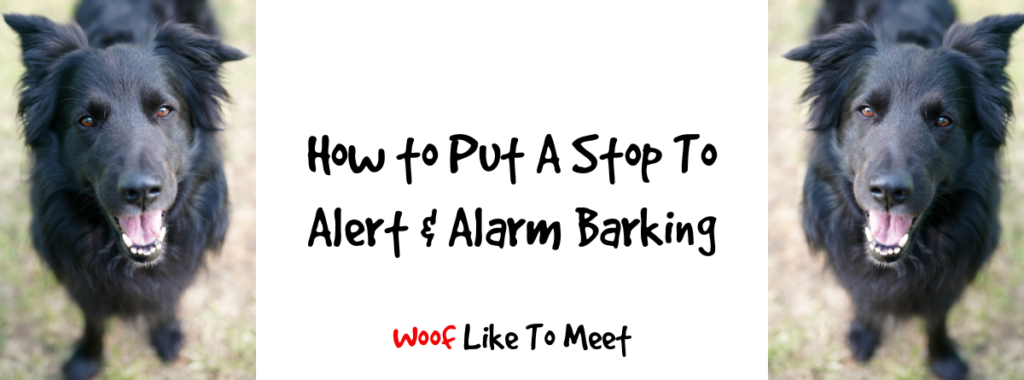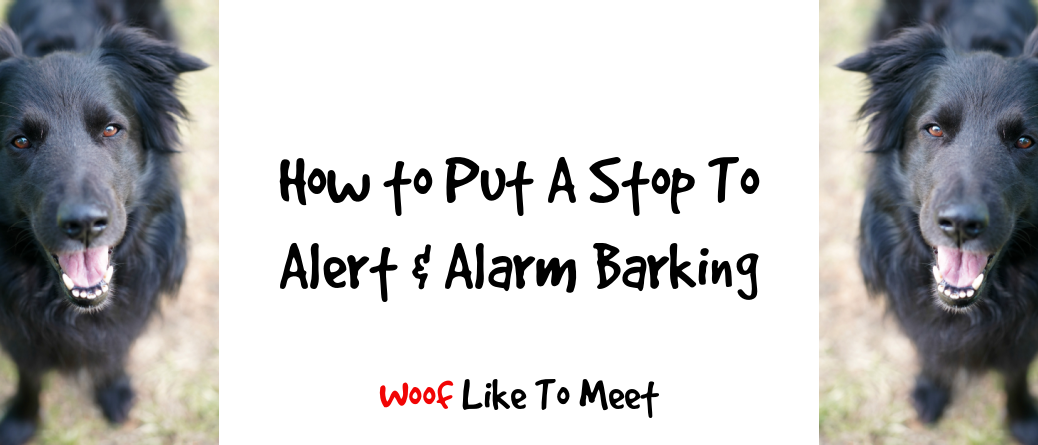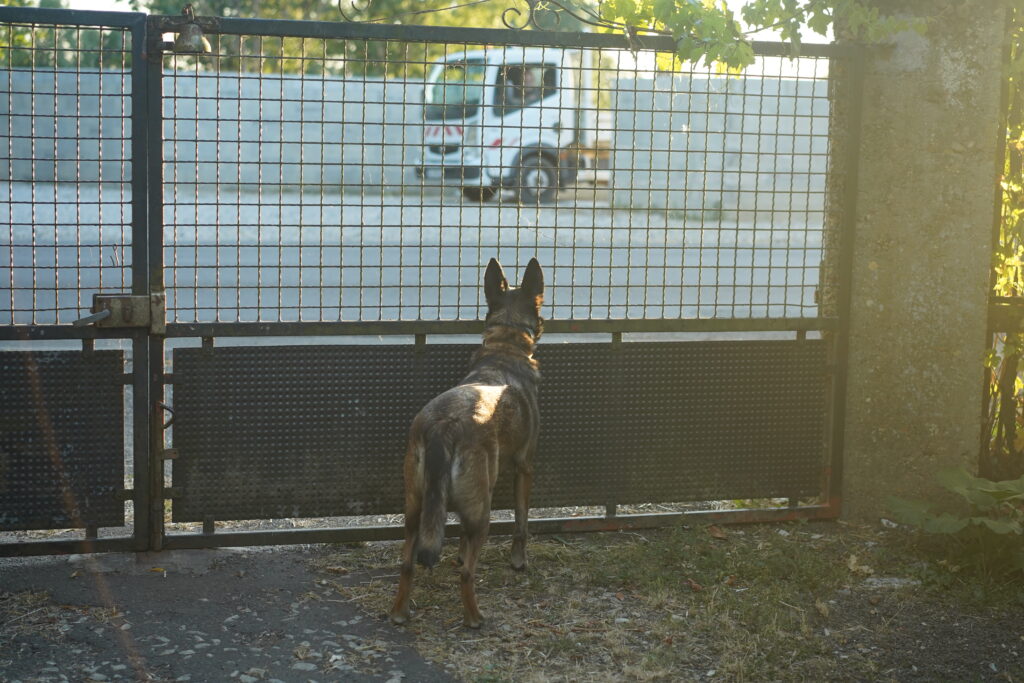
Many of our dogs are typical ‘watch dogs’, whether they’re a huge Pyrenean Mountain dog or a tiny Lhasa Apso. If you’ve got a dog who drives you nuts by barking at every pedestrian, cyclist, jogger, car or truck that passes your house, or who barks in the garden in response to all the other dogs in the neighbourhood barking, read on and find out a really simple way to put an end to your dog barking to alert you to everything outside the door that offends them.
Why dogs alert bark
The simple fact is that most dogs on the whole bark much, much more than wolves, which gives us a clue that their barking has served a purpose. Indeed, many of the earliest recorded accounts of dogs include stories about dogs who were kept to alert the home-owner to potential intruders. The watch dog was probably one of the earliest roles dogs played in our lives.
Today, the simple fact is that many dogs can’t distinguish between an intruder and a passer-by. It becomes a superstition for many dogs that they feel they need to bark in order to make the offensive stuff outside the door or gate leave. They don’t realise that it’s not their barking that has made the offensive individual go away, but that they went away anyhow and they always intended to.
Recently, a big family and business moved into the house across the road from me. They also have a very noisy dog who likes to bark every time the cars pull up. The dog is outside most of the day and it’s easy to tell when people are coming and going.
The problem is that my dogs also like to bark at cars that pull up and also bark at dogs who are barking in the neighbourhood. You can imagine what a challenge it could have been for my dogs to cope with vans coming and going all day and with their dog barking every time they do.
So how do we stop this?
Step 1: identify triggers
Make a list of all the things that make your dog bark. Take a sample over 72 hours. Note how long they bark for and what they’re barking at. Even if you don’t know precisely what, because you can’t hear what they are, make sure that they’re reacting to things outside the property, not inside. Recognise patterns and also recognise the most challenging parts of your dogs’ day. For me, that was early morning and lunchtime. The triggers were generally neighbourhood noise which is worsened as people come and go. The post van is also a challenge. Note whether those things are visual or auditory.
Step 2: remove perches and vantage points
Many of our dogs use the backs of sofas or even coffee tables to stand on to keep an eye on the outside world. Who knows – they may even think that’s their job!
Your first job is to make it more difficult for your dog to see out of the window, to stand on couches or tables to look out, and to block up their access points. Move your couches, use screens, add stick-on filters, put plants in strategic places or even relocate to another room in the house temporarily. All these are temporary measures until you have things under control. Don’t worry – you can put your couch back in its rightful spot in a few weeks.
If your dogs are very sensitive to noise, you might even want to make sure you can give them a sound-proofed space with some inoffensive ambient music at busy times. But be careful you aren’t just adding to their problems by making it difficult for them to rest.
Remove vantage points and viewpoints outside too if your dogs bark at things beyond the property line.
Gates like this are perfect for encouraging barkers. If you want to have a fighting chance, it’s important to block off those vantage points. Here, some bamboo panels would be an easy solution, as long as we remember to block off the space around the solid panels too.
Step 3: give them something to do at critical times
My neighbour goes out to work at anywhere between 7.36 and 7.47. I know because his dog goes nuts. It’s winter and he also leaves his van warming up for ten minutes, so it tends to be a prolonged barking session just outside my window until he’s gone.
At 7.30, we have our breakfast. The dogs have Kongs, a bit of Classic FM, some highly offensive (to me) but highly valuable dog swag and a snuffle mat. At 7.50, we’re finishing up our breakfasts. Not a bark to be had.
Now I could give my dogs their breakfast at 7am and spend 10 minutes telling them to shut up at 7.36. I could give them a bowl at 7.30 and spend 10 minutes telling them to shut up at 7.36. If my dogs notice the comings and goings (they do) they’re more invested in eating breakfast than barking. Don’t make it easy for your dogs to bark at the most difficult times simply because they’ve nothing else to do. What stops me curtain twitching and cursing my neighbours? Occupation. What stops my dogs waiting around for stuff to happen? Occupation.
Step 4: prepare yourself to put an off-switch on your dog’s barking
It’s not realistic to expect your dogs never to bark. They’re dogs. Also, if you have a burglar, a bit of barking probably wouldn’t go amiss. But we can’t easily teach our dogs to distinguish between intruders and passers-by. All we really want is our dogs to stop when we ask and perhaps to start barking less frequently. After all, that’s probably why we tell them so many times to stop!
To prepare yourself for the off-switch, you need some high-value treats, preferably freeze-dried. It’s no good using fresh meat or cheese unless you have a cooler, because you need to keep the treats to hand. But you want high value treats – not just big brand floury biscuits. Your dogs will stop so much more quickly if you make it worth their while.
Step 5: cache your treats away from the scene of the crime
My dogs like to bark near the window in the living room, since that is closest to the road. I store my treats in a jar on the mantelpiece which is on the opposite side of the room. This has two purposes. One is to establish clear patterns about what happens when they need to bark. The other is to move them away from the window and create distance. Yes, it’s annoying to get up every time to go there myself. No, it’s not more annoying than yelling at them to stop barking for ten minutes. Look at it this way: you don’t have to get up off the couch and give them a treat, you get to move and get some exercise in return for their immediate silence.
Step 6: thank your dog and mean it
The next time your dog barks because something offensive to them is happening outside, with your most sincere and well-meant, heart-felt gratefulness, thank them!
Say, “Thank you! You are the best dog in the whole of the universe!”.
Say, “Well done, you magnificent creature!’
Say, “Good job, my loyal and most excellent bodyguard!”
Tell them they are wonderful and give them a treat away from the scene of the crime. Really mean it. Remember they save your from burglars, intruders, debt collectors, vagrants, hobos, would-be marauders, insurrectionists, odd-bods, religious acolytes, ne’er-do-wells, anarchists, miscreants, errant SWAT teams, hired assassins and warmongers on a daily basis. Thank them and feed them. They do not know you are not Halle Berry in John Wick and they are not Belgian Malinois. As far as they are concerned, you are their most valuable asset and they are the Best Guardians in the Known Universe.
Don’t worry the first ten times or so if they don’t stop instantly, or if they keep popping back to have the final say. Thank them anyway, sincerely, and from the bottom of your heart.
Remember, too, that the higher value your treats (at least at first), the more surprising this will be and the more amazing your results will be.
Feed for the entirety of the time the offensive thing is in radius of the house or garden. It’s better to use five or six treats and go slightly longer than the intruder is in range than hope that one will do.
Make sure you pick a phrase and use it every single time, like ‘thank you!’ or ‘good job!’
This phrase will become your off-switch. It tells the dogs they don’t need to bark any more and they’ve done what they were designed to do. They can bark, and as soon as you say the magic phrase, all is well. Partly, this is about your response to the scary stuff. If you’re silly and relaxed, your emotions will be as contagious as your previous hostility and anger. You can of course say, ‘Stop!’ or ‘That’s enough!’ but most of us have tried that already. Also, they don’t tend to be filled with nascent pride that our fierce dog has actually, for once in their life, followed our directions.
Step 7: add in some other stuff to stretch out the treats
You can ask your dog to ‘get it!’, to find the treat, to ‘watch!’ or play slow treats, where you’re practising impulse control. This way, you can spend two or three minutes with only a handful of treats. Keep them moving and busy, rather than asking them to sit for five minutes while a man chainsaws trees outside your home. Being still in the face of threat is hard. Keep your dogs busy and occupied until the offensive individual or machine has well and truly gone.
Step 8: practise until your dogs are 100% reliable
When your dogs are completely reliable, when you know you could say ‘thank you!’ and they would stop instantly, then you’ve cracked it. Would you put money on being able to say ‘Well done!’ during a work zoom call and your dogs stopping barking straight away? If not, you’ve got a bit of work to do yet.
You’ll find by this time that they are less sensitive to noise because you’ve also been getting them used to the noise or the offensive passer-by and pairing it up with good stuff. But never cheat your dog before they get to reliability. If there is a scary noise or intruder, ALWAYS thank them and ALWAYS give them a treat. Do this every time they bark. It’s a 100% thing. If you’re in and they alert, bark or otherwise notice something outside, then you give them a treat until you’d put money on them running straight to the treat spot when you tell them how magnificent they are.
Step 9: add in praise or petting occasionally
When your dogs are 100% reliable, you can swap in the simple ‘Thank you!’ or ‘Good job!’ or ‘Well done!’ without a treat. Your cue to stop will have been learned as a conditioned reinforcer: praise. You can add a game if you like. You can give them a bit of petting or attention. Start varying what good stuff happens when they’re quiet when you ask. Start with the minor offences, where it’s a slight growl or a head looking towards the window.
Never phase out the treats completely. Remember that the stuff outside your window or your gate IS a threat to your dog if that’s what they think it is. If you stop the treats, expect the behaviour to return. Keeping an occasional treat every so often, even going back to 100% treats for stopping barking for a short while, can help keep it fresh and exciting. You may find that barking drops off so much that you can keep to 100% treats. I do, simply because barking is so extremely rare that it’s a small price to pay for the quiet. If I get through 10 treats a month, it’s been a crazy week. That’s down from 10 treats an hour. I’m happy with that.
Step 10: thank the smaller behaviours
So what do you do if you hear or see something?
If you see your dog look but not bark, thank them and give them a treat. If you hear them growl, thank them and give them a treat. If they were resting and they open their eyes slightly, thank them and give them a treat. Switch in the praise and petting if you barely get a reaction. What you are doing is shaping smaller behaviours so they don’t need to bark to tell you several SWAT soldiers are rappelling down your house front and you’re going to have to take your diamond stash to the safe room.
So, in essence:
When there are offensive things outside:
* say ‘Thanks!’
* go get the dog a treat away from the gate, door or window
* keep giving the treats until the offensive things go away
* repeat until it’s a well-established habit.
In this video, my friend pulls up to drop something off. Neither of my dogs bark. I wanted them to. I even ask them, ‘Who’s there?’ hoping one of them will. They don’t even then. That’s how good this technique is. There really is someone outside — my girl looks at the window on the right a few times, but not a bark was uttered between the pair.
Lidy, the malinois, notices the car door opening and the car running. Heston, the groenendael cross, is still my huge fanfare barker and even he doesn’t utter a peep. He doesn’t even look out of the window. I videoed it for you because I’ve been trying to catch them barking for 3 days and they haven’t barked once. There have been multiple disturbances of cars, vans, dogs barking, cyclists parked up outside chatting, post vans, the kid over the road playing kick-ball against the side of their house, gunshots, hunters, hunt dogs and even fire sirens. And I’ve waited. This was the one moment where I thought I would get some lovely barking. I got none. Heston looked out of the window and looked at me. We went to the mantelpiece anyway because it’s always worthwhile topping up with the challenging moments. We play until my friend leaves. Then the treats are gone.
If you are worried that your dogs will start barking to get treats, I’m happy to say this activity does not work like this. Because the dog only barks when there is something to bark at (and you can, by the way, do this if you suspect the dog hears something you don’t) then they only do it then.
Please note: this activity is not suitable for dogs who are barking AT you to get your attention or if they ever bark at you for food. It’s also not suitable if people are going to come into your home, though it may work in the same way. You can also do this with doorbells or if your dog barks when the phone rings.
So if your dog is alert barking, it’s well worth trying this simple technique to reduce the number of times they bark, and how much they bark as well as putting their silence on cue. It’s made my life much more bearable, especially as noise has increased outside my home. And I like to hope it has made my dogs’ lives more bearable too because I’m not yelling at them to stop or hoping they’ll just stop of their own accord.
I’ve got an exciting new book out for dog trainers. If you’re interested in working more efficiently, more effectively and with less coercion, I wrote this to get you thinking! Available on Amazon in paperback and ebook.



